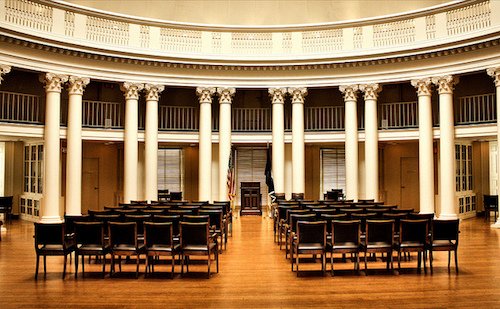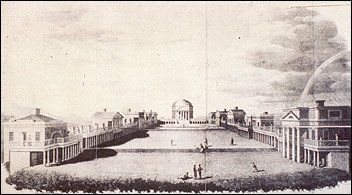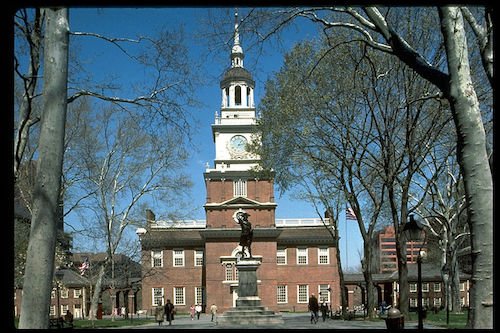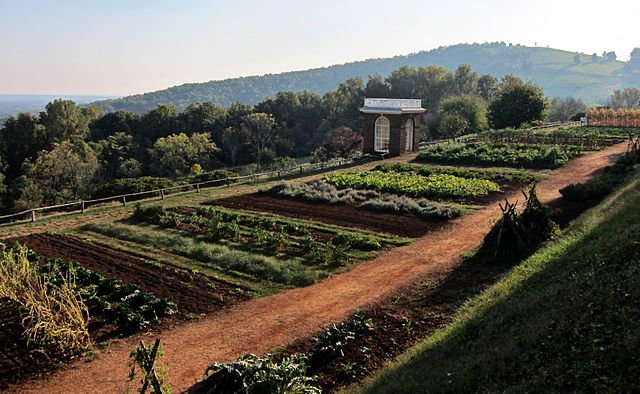Thomas Jefferson is perhaps the most recognizable American Founding Father, and served the country during its infancy in multiple roles before becoming President of the United States in 1800.
A big believer in Washington playing a limited role in citizens’ lives, the Republican Party owes a debt of gratitude to his anti-federalist approach and championing of individual liberty and states’ rights.
Jefferson’s well-documented ownership of slaves is a dark cloud of an otherwise illustrious career of public service and philosophical inquiry.
Here are five things to know about the third president of the U.S.:
He was privileged from the beginning

A painting of Monticello, 1825. (Wikimedia Commons)
Jefferson lived an aristocratic lifestyle on a plantation in western Virginia, attending boarding school and studying classical languages along with his private minister and teacher. In 1760, he enrolled at the College of William and Mary before pursuing his legal studies with the legendary George Wythe.
While practicing law, Jefferson met and married a widow from high society named Martha Wayles Skelton. The pair moved onto his plantation into a small house, which he would later redesign into a neoclassical masterpiece that he called Monticello.
He designed the University of Virginia

Flickr/Phil Roeder
Along with the Monticello property, Jefferson designed the University of Virginia in nearby Charlottesville. In 1987, it became the first and only American college to be designated a UNESCO World Heritage Site along with his Monticello mansion.
“It is safer to have the whole people respectably enlightened than a few in a high state of science and the many in ignorance,” Jefferson said. Therefore he designed the campus as a sort of village where information could be shared freely, and at the center of it was a Temple of Knowledge — or, as we would call it, university library.

(The Albert & Shirley Small Special Collections Library, University of Virginia Library)
Indeed, the modern college campus — and by extension, the layouts of headquarters for companies such as Amazon, Facebook, Google and Apple — was an idea first hatched by Jefferson.
He authored the Declaration of Independence

Independence Hall, Philadelphia. (Wikimedia Commons)
It was evident early on that Jefferson was a gifted writer and orator, so much so that it was he who the duty befell to write the first draft of that living document which would become the basis for the United States of America.
In 1776, colonial America was through with taking orders from and handing taxes to the King of England and stated their desire for separation from Britain. The Continental Congress selected five men to hash out the document officially stating their sovereign rights: John Adams, Roger Sherman, Benjamin Franklin, Robert Livingston and Jefferson.
It was here that he wrote his most famous words, intertwined with the legacy of American civilization forever: “Life, Liberty and the pursuit of Happiness.” The document established a Continental Army with the leader of George Washington, who would later name Jefferson the country’s first secretary of state.
He purchased the Louisiana Territory from France

Wikimedia Commons
Maybe this is the inspiration for “The Art of the Deal,” we’ll never know. Somehow Jefferson pulled off the acquisition of a lifetime when he approached Napoleon Bonaparte about the purchase of the Louisiana Territory, which stretched for some 820,000 miles from present-day Canada to the Gulf of Mexico, and over to the Rocky Mountains.
After Spain’s King Charles IV signed a decree transferring Louisiana back to the French, Napoleon aimed to expand his influence on the region. However, Jefferson dispatched future president James Monroe and Robert Livingston to negotiate the terms of the sale, which was finalized on the heels of the Napoleonic Wars that would consumer the young commander for the duration of his time in power.
He had some interesting relations with his slaves

Monticello vegetable garden (Wikimedia Commons)
Although Jefferson had begun drafting documents that would lead to the abolishment of human slavery, he had many Africans in his employ on the plantation in Virginia. Around 600 of them, to be exact. He believed that the practice would not see total abolishment unless the practice was denounced on a large scale, and the former slaves were free.
Mostly, however, he viewed them as part of his capital — a contradictory belief to his words that “all men are created equal.” And at with least one of them, Sally Hemmings, he is thought to have fathered multiple children.
If you want to know more about the life of the slaves on Jefferson’s 5,000 acre home, there is an app for that.
